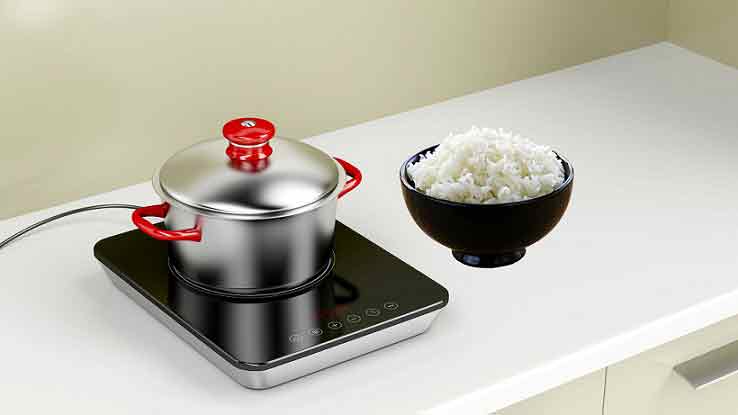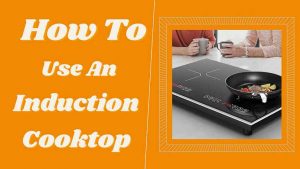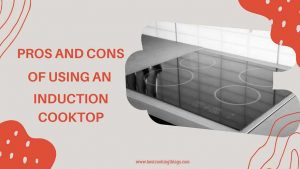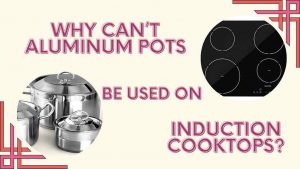Induction cooktops have gained immense popularity in recent years due to their efficiency and convenience. They provide precise temperature control, faster cooking times, and easy cleanup. However, one common question that arises when using an induction cooktop is, ” How much weight can we put on an induction cooktop? ” In this article, we will explore the weight capacity of induction cooktops, factors that affect it, and important considerations for safe and effective usage.
Weight Limit Guide:
| Size (Width x Depth) | Weight Limit |
|---|---|
| 30 cm x 30 cm | Up to 10 kg |
| 60 cm x 60 cm | Up to 20 kg |
| 90 cm x 60 cm | Up to 30 kg |
Please note that these figures are approximate and may vary depending on the specific model and manufacturer. It’s essential to refer to the user manual or specifications provided by the manufacturer for precise weight limits for your induction cooktop.
Now, for an informative guide about the weight limits of induction cooktops:
- Understanding Weight Limits: The weight limit of an induction cooktop refers to the maximum weight it can support without compromising its safety and performance. Exceeding this limit can lead to damage to the cooktop or even pose a safety hazard.
- Factors Affecting Weight Limits: The weight limit of an induction cooktop depends on several factors, including its size, construction, and the materials used. Larger cooktops generally have higher weight limits due to their sturdier build and larger surface area to distribute weight.
- Manufacturer’s Specifications: It’s crucial to consult the user manual or specifications provided by the manufacturer to determine the exact weight limit for your induction cooktop model. These documents typically include detailed information about the maximum weight capacity and any specific guidelines for using the cooktop safely.
- Installation Considerations: When installing an induction cooktop, it’s essential to ensure that the countertop or surface on which it will be placed can support its weight. If the cooktop is installed in a location where it might be subjected to additional weight, such as heavy pots and pans, the overall weight capacity should be considered.
- Maintenance and Care: Proper maintenance and care of the induction cooktop can also impact its weight limit over time. Regular cleaning and avoiding heavy impacts or loads beyond the recommended capacity can help prolong the lifespan of the cooktop.
- Professional Installation: If you have any doubts about the weight limit or installation of your induction cooktop, it’s best to consult a professional installer or the manufacturer for guidance. They can provide specific advice based on your cooktop model and installation requirements.
What is an Induction Cooktop?
An induction cooktop is a modern kitchen appliance that uses electromagnetic fields to directly heat the cookware. Unlike traditional gas or electric cooktops that rely on thermal conduction, induction cooktops generate heat through electromagnetic induction. This method allows for faster and more efficient cooking.
How Does an Induction Cooktop Work?
Induction cooktops consist of a series of copper coils beneath a ceramic surface. When an electric current passes through these coils, it creates a magnetic field. When a compatible magnetic cookware is placed on the cooktop, the magnetic field induces electric currents within the cookware, generating heat directly. This process ensures that the cooktop itself doesn’t get excessively hot.
Benefits of Induction Cooktops
Before delving into the weight capacity of induction cooktops, let’s explore some of their key benefits.
- Precise Temperature Control: Induction cooktops offer precise temperature control, allowing you to adjust heat levels with accuracy. This feature is particularly beneficial for tasks that require specific temperatures, such as simmering delicate sauces or melting chocolate.
- Faster Cooking Times: Due to their efficient heat transfer, induction cooktops can significantly reduce cooking times. They heat up quickly, allowing you to start cooking immediately and saving valuable time in the kitchen.
- Energy Efficiency: Induction cooktops are highly energy-efficient as they directly heat the cookware. They waste minimal heat since the energy is focused only on the cooking vessel, making them more eco-friendly and cost-effective.
- Easy Cleanup: Since the cooktop itself doesn’t get hot, any spills or splatters are less likely to burn onto the surface. This makes cleaning an induction cooktop a breeze, requiring only a quick wipe-down after cooking.
Caution: When you are thinking of buying an induction cooktop, you must try to buy the best induction cooktop in terms of quality. If you have no prior experience with induction cooktops then you have not seen the comments of real users of induction cooktops. This will give you an idea of which induction cooktop you should buy.

Factors Affecting Weight Capacity
The weight capacity of an induction cooktop is influenced by several factors. Understanding these factors is crucial for ensuring safe and optimal usage.
Cooktop Design:
Different induction cooktop models have varying weight capacities based on their design and construction. It is important to consult the manufacturer’s guidelines or user manual to determine the maximum weight limit for your specific cooktop.
Induction Coil Quality:
The quality and strength of the induction coils play a role in determining weight capacity. Cooktops with higher-quality coils can typically handle heavier loads.
Construction Material:
The material used for constructing the cooktop surface affects its weight capacity. Cooktops made from durable materials like tempered glass or ceramic can generally support more weight compared to those made from less sturdy materials.
Installation Method:
The method of installation can impact the weight capacity of an induction cooktop. Cooktops that are built-in or flush-mounted tend to have higher weight capacities compared to portable or countertop models. It is essential to follow the manufacturer’s instructions for proper installation to ensure maximum weight support.
Maximum Weight Capacity
The maximum weight capacity of an induction cooktop varies depending on the model and manufacturer. Typically, induction cooktops can support weights ranging from 30 to 50 pounds (13 to 23 kilograms). However, it is crucial to check the specific weight capacity mentioned in the product documentation or consult the manufacturer to ensure you do not exceed the recommended limits.
Weight Distribution
While considering the weight capacity, it is also essential to pay attention to the distribution of weight on the cooktop surface. Uneven weight distribution or placing excessively heavy objects on one side of the cooktop can cause imbalance and potentially damage the appliance. It is advisable to evenly distribute the weight of the cookware across the cooking zone to maintain stability and prevent any strain on the cooktop.
Cookware Considerations
Apart from the weight capacity of the cooktop, the weight and material of the cookware itself play a crucial role. Induction cooktops require compatible cookware that can generate the necessary magnetic field for heat induction. Most induction-compatible cookware is made from materials such as stainless steel or cast iron. It is important to select cookware that is within the weight limits recommended by the cooktop manufacturer to ensure safe and efficient cooking.
Safety Measures
When using an induction cooktop, it is essential to follow certain safety measures to prevent any accidents or damage:
Avoid Overloading:
Do not exceed the recommended weight capacity of the cooktop. Overloading can strain the appliance and lead to malfunctions or damage.
Use Proper Cookware:
Ensure that the cookware you use is compatible with induction cooking. Look for the induction symbol or check the manufacturer’s instructions to verify suitability.
Center Placement:
Place the cookware in the center of the cooking zone to ensure even heat distribution and prevent uneven weight distribution.
Avoid Sliding:
Do not slide or drag heavy cookware across the cooktop surface, as it can cause scratches or damage the induction coils.
Maintenance and Care
To maintain the performance and longevity of your induction cooktop, follow these maintenance and care tips:
- Regular Cleaning: Clean the cooktop surface after each use to remove any spills or residue. Use a non-abrasive cleaner and a soft cloth to prevent scratching the surface.
- Avoid Harsh Cleaners: Avoid using harsh or abrasive cleaners that can damage the cooktop. Opt for gentle cleansers specifically designed for induction cooktops.
- Protect from Impact: Prevent any heavy objects from falling or hitting the cooktop surface, as it can cause cracks or damage.
- Professional Servicing: If you encounter any issues or suspect a malfunction, contact a professional technician for servicing and repairs. Do not attempt to fix the appliance yourself to avoid any accidents or further damage.
Popular Induction Cooktop Models
There are several reputable brands that offer high-quality induction cooktops with varying features and weight capacities. Some popular models include:
- Brand X Model A: This model boasts a weight capacity of up to 45 pounds and offers advanced temperature control and sleek design.
- Brand Y Model B: Known for its durability, this model can support weights of up to 50 pounds and offers multiple cooking zones for versatile meal preparation.
Induction Cooktop vs. Gas Cooktop
Induction cooktops and gas cooktops have their own set of advantages and considerations. Here’s a brief comparison:
Induction Cooktop:
- Offers precise temperature control, allowing for accurate cooking.
- Heats up quickly, reducing cooking times and saving energy.
- Provides a safer cooking experience as the surface remains cool to the touch.
- Requires induction-compatible cookware for efficient cooking.
- Easy to clean and maintain with a smooth, flat surface.
Gas Cooktop:
- Provides instant heat control and visual flame for precise cooking.
- Works with any type of cookware, making it versatile.
- Allows for high-heat cooking methods like wok cooking.
- Requires a gas supply and proper ventilation for safe usage.
- Cleaning can be more challenging due to the presence of burners and grates.
The choice between an induction cooktop and a gas cooktop ultimately depends on personal preferences and specific cooking needs.
Induction Cooktop vs. Electric Cooktop
Similarly, let’s compare induction cooktops with electric cooktops:
Induction Cooktop:
- Offers faster heating and precise temperature control like electric cooktops.
- Provides efficient heat transfer, reducing cooking times.
- Requires induction-compatible cookware.
- Offers a cooler surface and increased safety.
- Can be more energy-efficient compared to some electric cooktop models.
Electric Cooktop:
- Offers a wide range of cookware compatibility.
- Can be more affordable compared to induction cooktops.
- Provides consistent and even heating across the cooking surface.
- Requires proper ventilation for safe usage.
- Cleaning can be more challenging due to the presence of burners and coils.
Conclusion
Induction cooktops provide efficient and convenient cooking experiences. While weight capacity is an important consideration, it is crucial to follow the manufacturer’s guidelines and not exceed the recommended limits. By understanding the factors affecting weight capacity, using compatible cookware, and practicing proper safety measures, you can enjoy the benefits of induction cooking while ensuring the longevity of your cooktop.
Frequently Asked Questions (FAQs)
Can I place heavy cast iron pans on an induction cooktop?
Yes, induction cooktops can handle heavy cast iron pans as long as they fall within the recommended weight capacity. Check the manufacturer’s guidelines for specific weight limits.
Is it safe to place multiple pots and pans on an induction cooktop simultaneously?
Induction cooktops can accommodate multiple pots and pans, but ensure even weight distribution across the cooking zones to maintain stability and prevent strain on the cooktop.
Can I use glass or ceramic cookware on an induction cooktop?
Induction cooktops require cookware that is compatible with magnetic induction. Glass or ceramic cookware usually doesn’t work unless it has an induction-compatible base.
Can I use an induction cooktop during a power outage?
No, induction cooktops require electricity to generate the electromagnetic field for heat induction. They do not work during a power outage.
How often should I clean my induction cooktop?
It is recommended to clean your induction cooktop after each use to prevent the buildup of food residue. Use non-abrasive cleaners and follow the manufacturer’s instructions for best results.
Also Read: How Efficient Are Induction Cooktops
How To Hard Boil Eggs On Induction Cooktop?
You Get More at “Best Cooking Things”
So stay with us

Types of Induction Cooktops – A Quick Guide | What to Know Before You Buy |

The Benefits of an Induction Cooktop: Efficiency, Safety, and More |

How to Use Induction Cooktop: A Complete Guide For Beginners |

|

How to Use Non-Induction Cookware on an Induction Cooktop – Step by Step Guide |

Alessandra Sarria is not only the creator but also a writer and editor of Best Cooking Things. He does most of the cooking at home. His friends and family members look forward to eating the delicious creations. He loves to cook. So he often writes about the problems or questions that arise while cooking at home. So that others do not get into trouble. One of the best ideas about which cooking tools are best can be found in his writings. From his own experience, he highlighted how different cookwares are.








Pingback: How to Use Non-Induction Cookware on an Induction Cooktop - Step by Step Guide